

Mask Africa Renewable Energy Food Security News Mask Africa Mask-Africa: Food Security. Costa Rican academics are pioneering the growth of crops on freshwater lakes as a way of addressing food shortages.
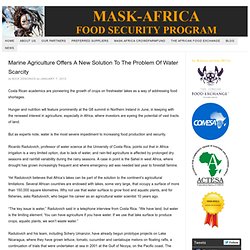
Hunger and nutrition will feature prominently at the G8 summit in Northern Ireland in June, in keeping with the renewed interest in agriculture, especially in Africa, where investors are eyeing the potential of vast tracts of land. But as experts note, water is the most severe impediment to increasing food production and security. Ricardo Radulovich, professor of water science at the University of Costa Rica, points out that in Africa irrigation is a very limited option, due to lack of water, and rain-fed agriculture is affected by prolonged dry seasons and rainfall variability during the rainy seasons.
A case in point is the Sahel in west Africa, where drought has grown increasingly frequent and where emergency aid was needed last year to forestall famine. Yet Radulovich believes that Africa’s lakes can be part of the solution to the continent’s agricultural limitations. Two Approaches for Optimizing Water Productivity / April 26, 2013 / News from the USDA Agricultural Research Service. By Dennis O'Brien April 26, 2013 U.S.
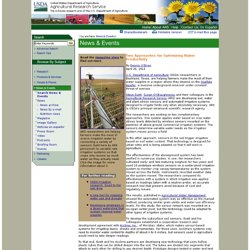
Department of Agriculture (USDA) researchers in Bushland, Texas, are helping farmers make the most of their water supplies in a region where they depend on the Ogallala Aquifer , a massive underground reservoir under constant threat of overuse. Steve Evett , Susan O'Shaughnessy and their colleagues in the Agricultural Research Service (ARS) are developing soil, water and plant stress sensors and automated irrigation systems designed to irrigate fields only when absolutely necessary.
ARS is USDA's principal intramural scientific research agency. The researchers are working on two complementary approaches. In the other approach, sensors in the soil trigger irrigation based on soil water content. The effectiveness of the aboveground system has been verified in numerous studies. Irrigation efficiency makes jump with iFarm app. NMSU civil engineering Professor Zohrab Samani and local farmer John Storm view data on iFarm, an online application developed by Samani to enable more efficient water usage on farms.
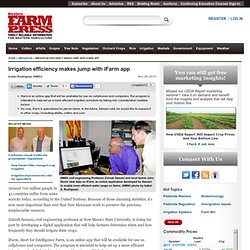
(NMSU photo by Isabel A. Rodriguez) Around 700 million people in 43 countries suffer from water scarcity today, according to the United Nations. Because of those alarming statistics, it’s now more important than ever that New Mexicans work to preserve the precious, irreplaceable resource. Zohrab Samani, civil engineering professor at New Mexico State University, is doing his part by developing a digital application that will help farmers determine when and how frequently they should irrigate their crops. iFarm, short for Intelligence Farm, is an online app that will be available for use on cellphones and computers. “The request came from the farmers,” said Samani, who began developing the program in summer 2011. How do you feed nine billion people? An international team of scientists has developed crop models to better forecast food production to feed a growing population -- projected to reach 9 billion by mid-century -- in the face of climate change.
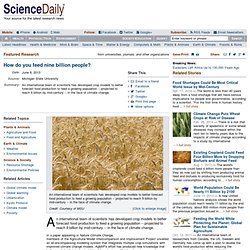
In a paper appearing in Nature Climate Change, members of the Agricultural Model Intercomparison and Improvement Project unveiled an all-encompassing modeling system that integrates multiple crop simulations with improved climate change models. AgMIP's effort has produced new knowledge that better predicts global wheat yields while reducing political and socio-economic influences that can skew data and planning efforts, said Bruno Basso, Michigan State University ecosystem scientist and AgMIP member. "Quantifying uncertainties is an important step to build confidence in future yield forecasts produced by crop models," said Basso, with MSU's geological sciences department and Kellogg Biological Station. SALUS was initially designed by Joe Ritchie, MSU emeritus distinguished professor. Global irrigated area at record levels according to research. In 2009, the most recent year for which global data are available from the United Nations Food and Agriculture Organization (FAO), 311 million hectares in the world was equipped for irrigation but only 84 percent of that area was actually being irrigated, according to new research conducted by the Worldwatch Institute.
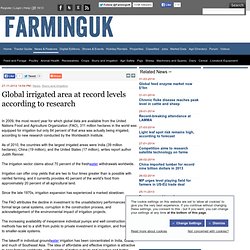
As of 2010, the countries with the largest irrigated areas were India (39 million hectares), China (19 million), and the United States (17 million), writes report author Judith Renner. Irrigation can offer crop yields that are two to four times greater than is possible with rainfed farming, and it currently provides 40 percent of the world's food from approximately 20 percent of all agricultural land. Since the late 1970s, irrigation expansion has experienced a marked slowdown. The increasing availability of inexpensive individual pumps and well construction methods has led to a shift from public to private investment in irrigation, and from larger to smaller-scale systems.
The real threat to our future is peak water. Peak oil has generated headlines in recent years, but the real threat to our future is peak water.
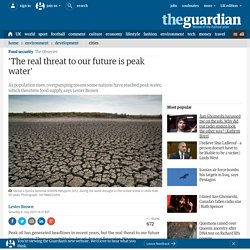
There are substitutes for oil, but not for water. We can produce food without oil, but not without water. We drink on average four litres of water per day, in one form or another, but the food we eat each day requires 2,000 litres of water to produce, or 500 times as much. Getting enough water to drink is relatively easy, but finding enough to produce the ever-growing quantities of grain the world consumes is another matter. Grain consumed directly supplies nearly half of our calories. During the last half of the twentieth century, the world's irrigated area expanded from close to 250m acres (100m hectares) in 1950 to roughly 700m in 2000.